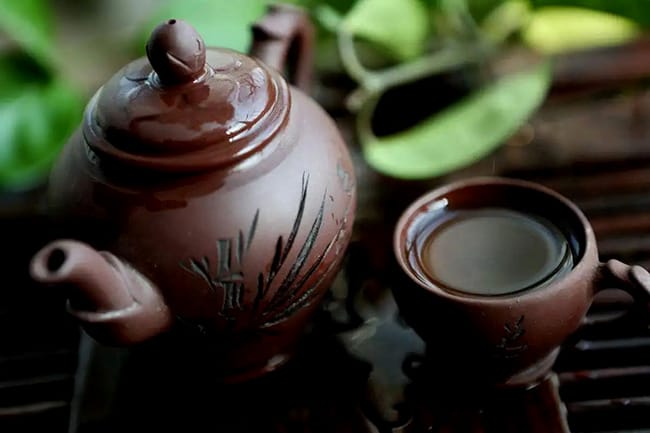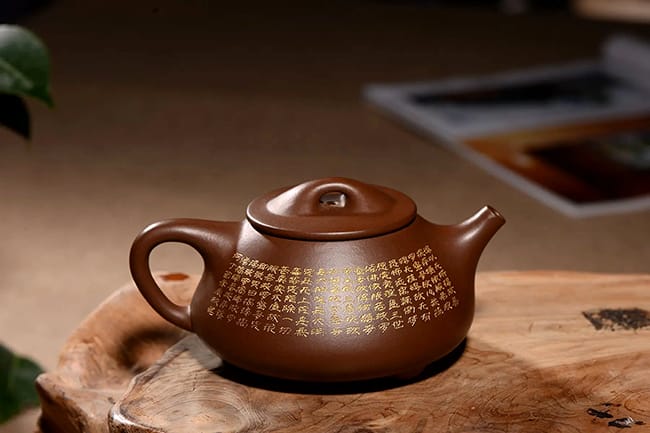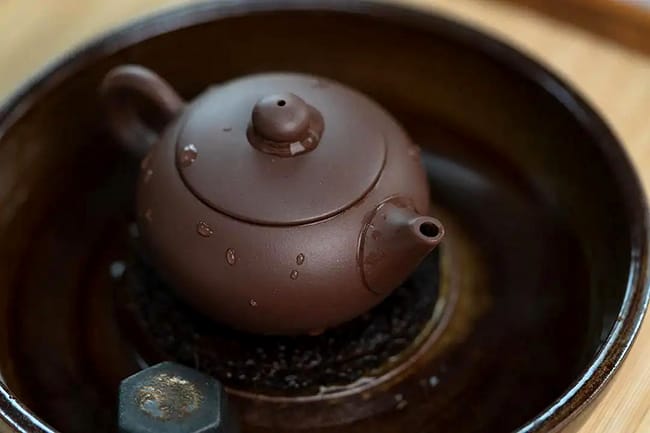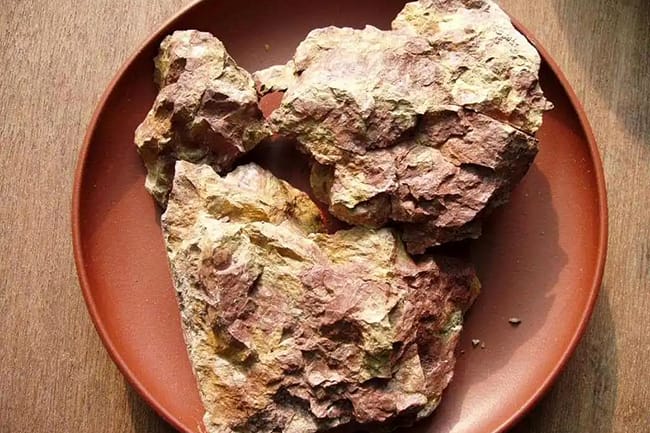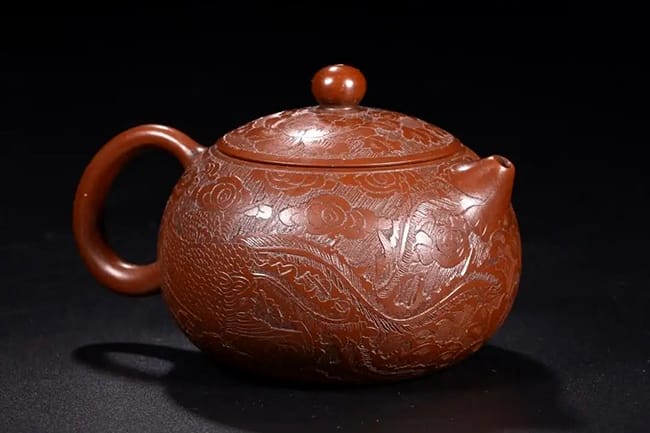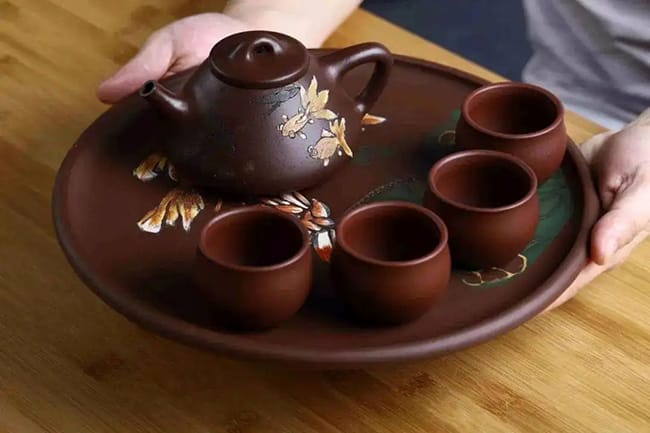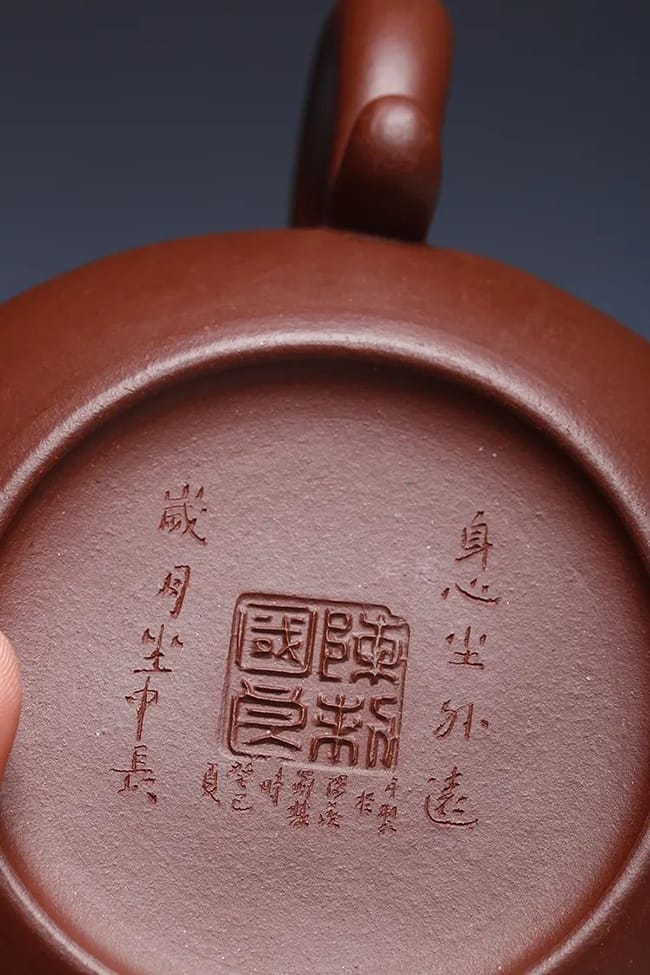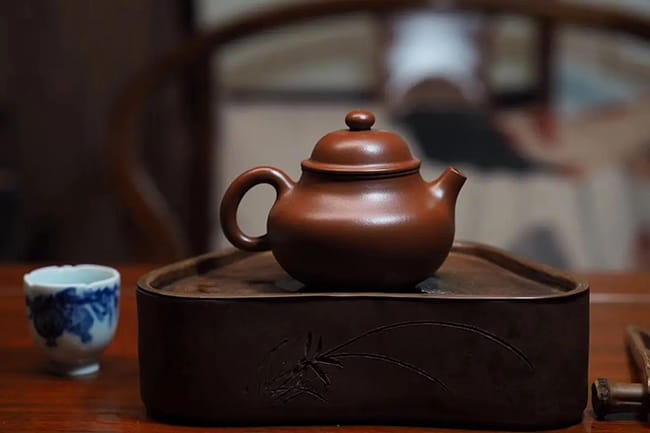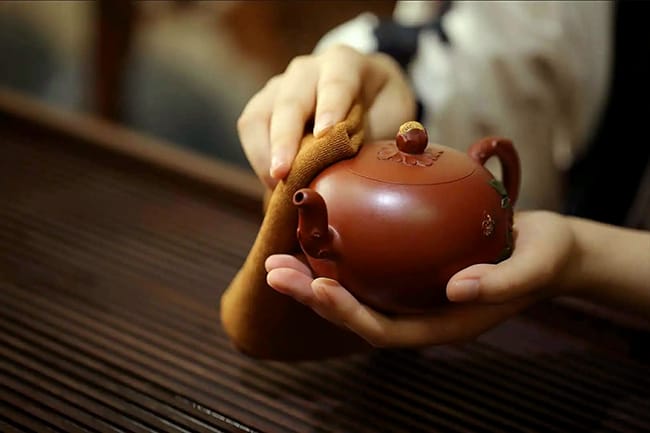Last Updated on 05/24/2022 by Desmond
What teapot is best for brewing tea? Many senior tea lovers may give you the same answer: a Chinese Yixing Zisha Teapot. These unglazed, soil-color small teapots show the beauty of nature, and the delicate carves are also fascinating. However, most of the time, the high price of a Zisha teapot is prohibitive.
Why did Zisha teapot win so many recognitions from tea lovers? Is it really worth the high price?
CONTENT
What Is Zisha?
First, we need to know what Zisha is – the raw material for making Zisha teapots.
Although Zisha means purple sand in Chinese, this raw material isn’t a kind of natural sand or soil but a special mineral. This mineral was early found and used at Yixing, Jiangsu, China, so a Zisha teapot made from the material mined from there is regarded as the most authentic. Of course, this kind of mineral is not unique to Yixing but also widely distributed in Changxing, Zhejiang region, even abundant reserves were found far in Northeast China.
Either ceramic or pottery wares are fired by natural clay; Zisha wares are much more special. After the minerals were mined out, ceramists needed to weather and smash them to powder first, then make them into clay. These clay blocks also need to be stored for a period of time then can for ceramic wares making.
History of Zisha Teapot
According to the archaeological discovery in Yixing, the earliest Zisha wares came in the Northern Song Dynasty time(960-1127). Some famous poets also described the Zisha teapots in their poems.
Zisha teapots were raised during the Ming Dynasty Wanli Period(1572 – 1620). A ceramist named Shi Dabin improved the processing of the Zisha teapot – respectively making out each part of the teapot with clay pieces and then putting them together. It was said that the way of flapping the clay pieces was invented by him too. This processing method has been circulating so far, and it is undoubtedly a significant improvement to Zisha teapot processing.
The Qing Dynasty was the golden time for Zisha teapot. An engraver named Chen Hongshou was the first to carve on the Zisha teapot. Since then, the Zisha teapot style developed towards various decorative patterns, and all kinds of poems, words, and pictures also started appearing on the teapot body.
Why Do People Love Zisha Teapot So Much?
The unique raw material gives Zisha teapot an advantage that other ceramic wares don’t have – it retains fragrance for a long time. Thus, export for teapots, Zisha is also used for making teacups or Gaiwan frequently.
During the firing processing, the gas created in clay then forms different sizes of bubbles. Some of them connect and form the paths. After cooling down, there are many invisible tiny pores on the teapot.
While we brewing hot tea with a Zisha teapot, a few vapors run out from these pores. But due to the surface tension, water won’t leak. Therefore, the air pressure inside stays in a delicate balance; it won’t overcook the leaves or let the temperature down soon.
The air paths in the teapot wall are winding and long, the tea fragrance stays in it and lasts for a long time. Some tea juice also remains in them, creating flavored tea stains. Some people don’t clean the Zisha teapot thoroughly after using it intentionally. They said that after a long time, you just need to fill hot water in the teapot and you can also get tea. Of course, it is an undesirable practice.
Another great advantage of a Zisha teapot is durable. It won’t easily break by expansion and contraction due to heat like porcelain ones. You can even directly heat it on the fire; if you don’t care about the smoke sooting its surface and losing its value.
Zisha Teapot Classify By The Clay’s Type
There are various styles of Zisha teapots, also the types. Some people classify them by the handle, body shape, or the spout; some according to the surface density, origins, or processing method. The most common standard is classifying based on the raw material types. (classifying by shape is also usual, but it’s very complicated, we won’t talk about that here.)
Although we call the material Zisha, it isn’t always purple. This is because the raw material, Zisha, is in rich color itself, so it is also called Five Color Soil. Worthing to know, about the color description of raw mineral, sometimes is based on the state while it was mined, sometimes is on the color after it fired. Also, the color description in different ages and languages often causes confusion.
Zisha mineral is typically classified into 3 types: Purple Clay, Green Clay, and Red Clay.
Purple Clay
Purple clay was also called “Cyan Clay” in the past, and it was the most usual material for making Zisha wares. Purple clay has excellent plasticity, high intensity, and less shrinking after being fired. Purple clay has 3 subtypes:
- Tian Qing Ni(Clay). It’s said the best Zisha clay, but it extinct a long time ago, only can be seen from the antique Zisha teapot.
- Di Cao Qing Ni. It gets this name because it is usually found in the bottom of the purple clay. The mineral shows purple-brown, dense clumps, with green spots, and turns red after being fired.
- Qing Shui Ni. It typically shows purple-brown, dense clumps, with mica chips in and light green spots. It turns red after being fired at normal temperature, and deep-dark or deep-green at higher temperatures.
Green Clay
Green clay is usually symbiotic with purple clay. The mineral shows grey-green, dense clumps, a little stiffness, rust and white wax covering the surface. Green clay has 3 subtypes:
- Ben Shan Lv Ni. It refers to the high-quality green clay origin in Huanglong Mountain(Ben Shan means the authentic mountain.) It shows light-green, dense clumps, turns light-yellow after being fired, and a higher temperature will lead to green.
- Zhi Ma(sesame) Lv Ni. It shows green, dense clumps. Many grains of sand come on the surface after being fired, and looks like full of sesame, so get the name.
- Mo Lv Ni. It is named for its dark green color, but it will turn to light yellow after being fired.
Red Clay
Red clay is a type named by the wares’ color after being fired, and it has 3 subtypes:
- Hong Pi Long. It typically origins in the macadam layer of the Huanglong Mountain surface, also called wild red clay. It shows grey-red, dense clumps, and turns dark red after being fired.
- Da Hong Pao(same name as a kind of Oolong tea). It contains ferric oxide, so it will turn bright red after being fired.
- Zhu Ni. The mineral shows yellow, dense clumps or blocks, even and delicate. After being fired, it turns a vermilion, but often out of shape.
Duan Ni
Except for these 3 clays, you may see some Zisha teapots made from “Duan Ni.” It typically refers to the clay that is symbiotic with the 3 clays above, so people don’t classify it alone. The color of Duan Ni after being fired is depends on the mineral clay it symbiotic with.
Besides, ceramists usually won’t make a Zisha teapot with only one type of clay but blend it with others to get different colors.
Why Are Zisha Teapots So Expensive?
When you are going to buy a Zisha teapot, you will find that their price range is so extensive: from several bucks to thousands. Most cheaper ones are absolutely fake; however, is a clay teapot really worth thousands of dollars?
Let’s see how they reach a high price.
The High-quality Raw Materials Are Rare
The high-price Zisha teapots are usually made from high-quality raw materials. Although Yixing is not the only place that origins Zisha mineral, the materials there are regarded as the most authentic, especially those from Huanglong Mountain(Ben Shan.)
The clay after being fired can’t be reshaped. The mineral is difficult to regenerate, but they’re still possible. It will take a long time, and the mining work will also cause some damage to the geological environment. April 2005 – June 2010, the Yixing government used to forbid the mining work on Huanglong Mountain, and implemented scheduled mining plans after unbanned. As a result, the high-quality raw materials once become scarce, and the costs rise.
Fortunately, due to the special processing requirements for Zisha wares, many ceramists store a certain amount of raw clays. Besides, the rising price of raw materials is still acceptable. Thus, the reasons for Zisha teapots’ high price are more from the complicated processing and celebrity effect.
Complicated Processing
It’s so complicated to make a Zisha teapot. The first challenge is that the raw Zisha minerals can’t be used directly after being mined but need to be a series of primary processing.
- Cleaning to remove impurity and do a simple classified;
- Weathering the minerals outdoor, making them into smaller clumps. It will take at least 3 months or longer to 1 year;
- After weathering, the mineral clumps need to be filtered with a strainer to remove impurity further. The meshes of the sieve decide the clay’s delicate degree; typically, it’s 60 meshes;
- Add water into the mineral powder, roll them into clay, place for days, then repeat it;
- After a month, add water to the clay blocks, then hit them to remove the air inside;
- Place the clay blocks in a dark and dank cellar for storing, watering them at times;
Precisely because of this complicated materials preparation job, many ceramists usually have a large stock. So the prohibition didn’t bring an obvious influence; still, many merchants ramped Zisha teapot’s price for this reason.
The following processing job is also difficult. Many ceramics will use a turntable to make regular clay wares easily, but Zisha clay is not so soft as commons. Ceramics need to cut a small block from the stock, flapping it with a hammer until it becomes an even plate.
The teapot body, lid, handle, spout, and base will be respectively made, then combined together. As for the various delicate carvings are only appear on the products that are full-handmade by the masters. Anyways, almost all the famous masters or studios will stamp on the Zisha teapot’s bottom or inside.
Due to the less contractility, the Zisha teapot after being shaped is almost the same as the final product; then it needs to be fired. A Zisha teapot typically needs to be fired 2-3 times. After the first time, the ceramist will check over it, and do the fine-tune job. During the firing, a few white quartz powders will be spread on the teapot opening to prevent the body and the lid from adhesion.
Even the senior master still costs 8-15 days to make a Zisha teapot in a full-handmade way or longer. Half-handmade or machine-made cost less time(we will talk about their differences later.) The complicated processing is a significant reason that causes the high price of a Zisha teapot. Most of the time, the leftover Zisha materials will be used to make tea pets so as not to waste.
Celebrity Effect
You may notice that most of the expensive Zisha teapots are made by someone famous masters. There is a stamp on the pot body and certificates in the package. These master ceramists all had great carving skills, and a deeper understanding of the Zisha teapot culture and processing. The most important is that every Zisha teapot is unique, and it’s why they can get a high price. These characteristics no doubt attract many collectors, and under the marketing promotion, the prices keep rising.
Differences Between Full-handmade, Half-handmade, and Filling-made
Full-handmade
Famous masters insist on handmade Zisha teapots. They take part in every step of the processing; some of them even mine and select the minerals themselves. They won’t take any tools to help during the shaping, but the final product still gets perfect symmetry and balance. Just because of this, every full-handmade Zisha teapot is unique.
Half-handmade
Some ceramists making Zisha teapots with molds help for saving time-cost. The mold-made teapots still can be carved, or be fired directly. A Zisha teapot item with lots of stock, and you can almost ensure that they are half-handmade. If you are not a collector, a half-handmade Zisha teapot may be your best choice.
Filling-made
Most Zisha teapots at an unbelievably low price are made in this way. The manufacturers fill the Zisha pulp(even not the real) in the molds for bulk processing. You can see noticeable casting lines on the teapot. And there will be many flaws because they haven’t been fine-processing.
Do You Really Need An Expensive Zisha Teapot?
Some sayings are that the Zisha teapot can not for brewing green tea; it’s not entirely correct. The features of a Zisha teapot are the great fragrance-retain and heat preservation performance. It’s indeed not so good for brewing green tea(it’s weak in aroma and can’t be brewed with hot water), but it still can use. Anyways, the Zisha teapot is much suitable for brewing Oolong, Pu-erh, and black tea, which are deep in fragrance.
Worthing to know is that senior tea lovers only brew one type of tea with a single Zisha teapot; they don’t want the left fragrance to affect the other brew’s flavor. And during the teapot raise(a maintaining custom,) brewing different types of tea also leads to the gloss on the teapot becoming muddy and mottled.
Assume you have a deep interest in tea, and you got enough budget, a Zisha teapot in hundreds of dollars assuredly can satisfy you; their price is similar to an excellent Jianzhan or Kyusu. And as for those great master full-handmade ones, which cost thousands of dollars or more, honestly, unless you have a social demand, then this is not so necessary for a tea-drinking interest.
How To Care For A Zisha Teapot?
To a real Zisha teapot, you need to be careful with the use and maintenance jobs.
There may be some white quartz powders inside the just bought back Zisha teapot, you need to clean them up with water and a soft brush. At the same time, there may be a smell; it will influence the tea flavor if you use it directly. A simple way to figure it out is to put it in a big pot, fill it with water, and heat it to boil for about 3 minutes, then dry it with a soft cloth. (never use cold water to cool the hot Zisha teapot down)
During use, the best way is just to use the Zisha teapot brewing just one type of tea. You can pour the tea left in the fair cup onto the teapot, then scrub it with a soft brush gently, let it absorb the juice and get a unique color. (it will take a long time)
After using, clean the Zisha teapot up, but do not use any detergents. Dry it with a soft cloth after cleaning. There are many tiny pores on the Zisha teapot, do not let the grease contact; it will make the surface get ugly, mottled glosses.
